
 numismatics and
currency - Numismatics
is the study or collecting of coins, medals
or currency -- any form of money. (pr. noo'miz-ma"tics) [This article will become
much more thorough soon.]
numismatics and
currency - Numismatics
is the study or collecting of coins, medals
or currency -- any form of money. (pr. noo'miz-ma"tics) [This article will become
much more thorough soon.]
Examples [illustrations do not represent their dimensions] :
![]()
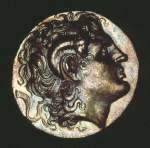
Thrace, Tetradrachm of Lysimachos, 323-281 BCE, silver. Also see relief.
Rome, Sestertius [denomination], 69-70 CE, Vespasian, Emperor 69-79 CE, bronze, reverse: Temple of Isis in Rome, diameter: 33 mm, Münzkabinett, Berlin. See Roman art.
Roman, Denarius,
Septimius Severus (Emperor 193-211 CE),
silver;
obverse: In the center
is a bust in profile
of Emperor Septimius Severus. He wears a laurel wreath. His hair
is curly, his beard ending in pin-curls. The inscription:
"SEVERVS . . . PIVSAVG" -- Severus Pius Augustus --
his name and the titles bestowed on him as emperor.
reverse: In the center
is Roma, the goddess of the city of Rome. In her left arm, she
holds a spear. A shield stands beside her, leaning against her
seat. The text is probably: "NOB . . VRBIS" -- noblissimus
urbis meaning noblest city. Michael Delahunt Collection. See
mythology and Roman art.
The principal coins of the Roman Empire and their relative values
| METAL | NAME | COMPARATIVE VALUE |
| gold | aureus | 25 silver denarii |
| silver | denarius | 4 bronze sestertii |
| silver | quinarius | 2 bronze sestertii |
| orichalcum | sestertius | 4 copper asses |
| orichalcum | dupondius | 2 copper asses |
| copper | as | 4 quandrantes |
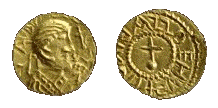
Anglo-Saxon, Kingdom of Kent, minted in London, England, Gold tremissis (shilling) of Eadbald of Kent, 616-40, gold, British Museum, London. This is the earliest coin bearing the name of an English king.

Anglo-Saxon, Kingdom of Mercia, England, Gold mancus of Coenwulf, 796-821, gold, British Museum, London.

Spain, 20 excelentes de la Granada of Ferdinand and
Isabella, 1492?, gold.
Germany, Berlin, Taler [denomination], 1786, silver, obverse: Friedrich the Great (1740 - 1786), diameter 35 mm, Münzkabinett, Berlin.
![]()
![]()
Germany, Prussia, 5 Talers [denomination], treasury-bill,
1856, engraving,
Münzkabinett, Berlin.

Kuba, Africa, Currency, bronze, copper,
4 15/16 x 7 3/16 x 6 3/4 inches, Minneapolis Institute of Arts.
See African
art.

![]()

United States, One Dollar ,1878-CC (Carson City Nevada mint), silver, obverse and reverse. Silver dollars of this design are also known as Morgan Dollars, after the sculptor who designed them.

![]()
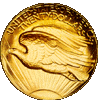
United States of America, Double Eagle, Twenty Dollars, 1907, 90% gold, 10% copper,
obverse and reverse.
Augustus Saint-Gaudens (American,1848-1907) was commisioned
to re-design
the coinage of the United States so that it would compare
favorably with the "beauty
and dignity" of ancient
Greek coins.


United States of America, Liberty Head Nickel, Five Cents, 1913,
nickel, obverse
and reverse. The Liberty
Head Nickel was abandoned in 1913 for the new Indian or Buffalo
Nickel. Only five clandestine specimens of the 1913 Liberty Head
Nickels were actually struck.

![]()
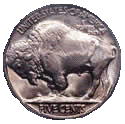
James Earle Fraser (American, 1876-1953), for the United States of America, Buffalo Nickel, Five Cents, obverse and reverse, 1914, nickel. The popular legend is that Fraser produced a portrait synthesized from three models: Iron Tail, Big Tree, and Two Moons, each a Native American chief who posed for Fraser in 1911. See profile.

United States of America, One Dollar Federal Reserve Note, 1988, recto and verso, engraving on paper (a cotton and linen blend, with red and blue minute silk fibers running through it), 2 5/8 x 6 inches. This design is similar to all one dollar bills produced from 1957-present. See articles about symbolism on the one dollar Federal Reserve Note, recto and verso.
United States of America, Specimen $500 Federal Reserve Note, Specimen $1000 Federal Reserve Note, Specimen $5000 Federal Reserve Note, Specimen $10,000 Federal Reserve Note, 20th century, engraving.
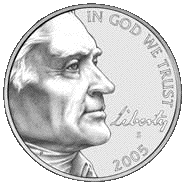
Joe Fitzgerald (American, 1951-), for the United States of America, Nickel, 2005, nickel. The previous design for a nickel was produced from 1938-2004 and was designed by Felix Schlag. See profile.
Also see counterfeit, die, exonumia, labyrinth, medal, metal, philately, relief, scripophily, and trussel.
https://inform.quest/_art